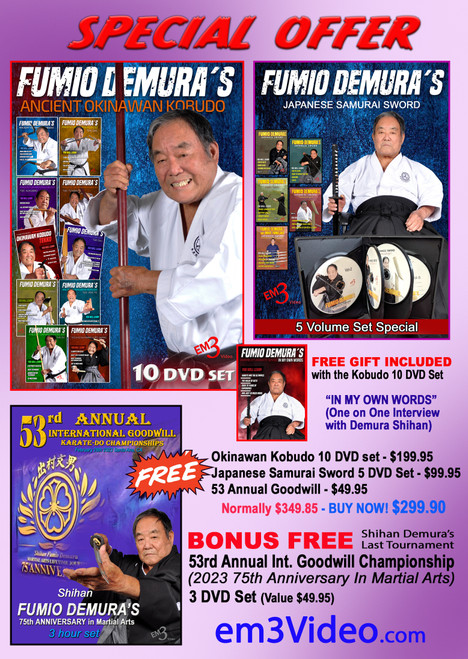Buy DVD 10 Set on this page
Fumio Demura's
Ancient Okinawan Kobudo Set + SWORD Set + 75th Anniversary Set - SPECIAL
INCLUDED:
The TEKKO is a farm tool from Okinawa Japan. It was originally 2 horse shoes tied together to defend against a sword and was also one of the most deadly weapons the Okinawa farmers had at their discretion to use. The three katas are from a much longer kata possibly coming from China. Tekko Kihon No Kata, Tekko Dai and Tekko Sho have rarely been taught outside of Okinawa till now.
THE MAE-TE is another ancient Okinawan Weapon that probably came from China where it was originally much longer and was used as a crutch. This unique weapon has many advantages over its sister weapon the tunfa as it extends itself by about 12” and as well can be used as a nunchaku be swung and then attack generating much more power.
The SAI IS one of the most celebrated Okinawan Kobudo weapon. Ilearn 4 of the most famous Okinawan Sai katas, Kihon No Sai, Tawada No Sai, Chatan Yara No Sai and Tsuken Shittahaku No Sai kata which has been handed down directly to Senbsei Fumio Demura from his Sensei who learnt it directly from Taira Shinken.
The KAMA famous for Okinawan Kobudo is the featured weapon in this DVD. It was used by the farmers of Okinawa for cutting rice and any other daily needs of the farmer. Sensei Demura is famous for teaching the use of this weapon all over the world. You will learn: * Kama Kihon No Kata*To No Nicho Gama No Kata*Kanegawa Nicho Gama No Kata.
The TONFA was a farmers tool that was used for grinding rice and other farm chores. Sensei Demura who trained with Ryusho Sakagami who was a direct student of Kenwa Mabuni shows his lineage is impecable. This DVD teaches HISTORY OF the tonfa and basics, bunkai and these two katas 1. Tonfa Kihon No Kata 2. Hamahiga No Kata.
THE NUNCHAKU teaching both single and double nunchaku. Filmed in real time and slow motion with detailed walk trough explanation. Included: 1. Nunchaku Kihon No Kata 2. Sosetsu Kon Ichi 3. Nijyuu Sosetsu Kon Ichi4. Shiken Sosetsu Kon Ni.
The KUWA or in english the Hoe is one of the most ancient weapons to come to Okinawa from China. The one and only form is called Kuwa Kihon No Kata created by Sensei Fumio Demura himself. You will also learn unique combinations bunkai and basics all related to this one weapon you will busy for months on end learning this weapon.
The EKU is a famous Okinawan weapon that simulates an oar used by Okinawan fishermen. The moves in these two katas Eku Bo Kihon Kata and Shiken Shitahaku Sunakake no kon are the two most popular Okinawan Eku katas that teach poking slashing smashing techniques that the fishermen would have used to defend themselves against the samurai who were attacking them. Bullet Points. LEARN *Two amazing Eku katas *The history of the Eku.
The BO This is one of the most comprehensive DVD's of all the weapons DVD's we have done with over 8 traditional katas, basic techniques, drills, demionstration techniques and much more as taught by Sensei Fumio Demura. Katas like Suchi No Kon Sho & Dai, Koryu Shushi, Sakugawa No Kon Sho and Dai, Soeishi No kon.
FURI GAMA (Kama) - This is probably the most exciting DVD in the series as you watch Thanh Nguyen spinning razor sharp kamas around like they were toys. You will learn 3 exciting katas made for competition for beginners Intermediate and advanced students. Watch as you see the intricate moves of this amazing agricultural tool from 1600 Okinawa.
Item: em3Video- 85-10Set ISBN: 0694536339552
PLUS FREE GIFT "In My Own Words" One on One interview with Shihan Demura
Samurai Sword BATTO-DO Series Vol-1-5 Volume SPECIAL by Fumio Demura
Option B: 5 individual DVDs (Not in a single case)
By Fumio Demura
Vol-1 SEVEN NOTE - KOME KATA - TOYAMA RYU KATA
Sword technique Toyama Ryu was devised emphasizing the most essential point of drawing and cutting from standing position. This modern Ryu has a strong emphasis on tamashigiri, or "test-cutting". Sensei Demura and his assistants teach you these intricacies and much more including: Seven Note, Kome Kata and Toyama Ryu Kata. Learn the secrets of this wonderful art form. Item: em3-85-12 ISBN: 0694536339729 TRT: 51 minutes
Vol-2 SUISHIN-RYU BATTO-DO SHITEI KATA - OBI - HAKAMA & TAITO
This instructional video teaches how to draw and cut against single and multiple attackers. It includes detailed demonstrations and explanation of posture, footwork, draw, cut and NOTO (returning the sword to the scabbard). Also how to put on, wear and take off the OBI (belt) as well as how to fold your Hakama.Item: em3-85-13 ISBN: 0694536339736 TRT: 46 minutes
Vol-3 KUMI-TACHI, TARGETS & TERMINOLOGIES
Basic sword kata performed with partner using BOKEN (wooden swords) allowing the practitioners to experience and train distance, timing and precision.
Usage of a bokken in their modern form first emerged during the Muromachi Period (1336–1600) for the training of samurai warriors in the various ryūs (schools of martial arts and swordsmanship) of the era. Bokken are safer than fighting with real swords, and are considerably more durable; a wielder can make contact with other trainee's swords with little fear of damage.
While bokken are safer for sparring and practice than katanas, they are still lethal weapons in the hands of trained users. A famous legend to this effect exists involves Miyamoto Musashi, a ronin known to fight fully armed foes with only one or two bokkens. According to the story, he agreed to a duel with Sasaki Kojiro at the early morning on Ganryūjima island. Musashi carved a crude bokken from an oar with his knife while traveling on a boat to the duel. At the duel, Sasaki was armed with his large nodachi, yet Musashi crushed Sasaki's skull with a single blow from his bokken, killing him. Item: em3-85-14 ISBN: 0694536339743 TRT: 29 minutes
Vol-4 TAMASHIGIRI (test cutting)
During the Edo period, only the most skilled swordsmen were chosen to test swords, so that the swordsman's skill was not questionable in determining how well the sword cut. The materials used to test swords varied greatly. Some substances were wara (rice straw), goza (the top layer of tatami mats), bamboo, and thin steel sheets. In addition, there were a wide variety of cuts used on cadavers and occasionally convicted criminals, from tabi-gata (ankle cut) to O-kesa (diagonal cut from shoulder to opposite hip). The names of the types of cuts on cadavers show exactly where on the body the cut was made. Aside from specific cuts made on cadavers, there were the normal cuts of Japanese swordsmanship, i.e. downward diagonal Kesa-giri (袈裟斬り), upward diagonal (Kiri-age (切上) or Gyaku-kesa (逆袈裟)), horizontal (Yoko or Tsuihei), and straight downward (Jodan-giri, Happonme, Makko-giri (真向斬り), Shinchoku-giri or Dottan-giri). Item: em3-85-15 ISBN: 0694536339750 TRT: 25 minutes
Vol-5 BASIC JAPANESE SWORD KNOWLEDGE SEMINAR By Mike Yamasaki
Mike Yamasaki has been involved in the study of Japanese swords for over 27 years. Studying both in the United States and in Japan, he has had the opportunity to attend several "Kantei Kai" or what is known as a sword identification challenge held monthly at the NBTHK. In 1998, he attended the NBTHK 40th anniversary national sword convention and received an award for placing 5th out of 200+ participants. Then again in Sept 2001, he became the first ever non-Japanese citizen to ever win this competition. The most recent NBTHK national convention (Nov 2008), he entered the challenge once again and landed 2nd place. The Nihon Bijutsu Token Hozon Kyokai (NBTHK), or the Society for the Preservation of Japanese Art Swords, was founded in Japan shortly after WWII and has existed since with the approval of the Japanese government. Item: em3-85-16 ISBN: 0694536339767 TRT: 46 minutes
Item: 85-12-16-set ISBN: 0694536339774-Option-B
FUMIO DEMURA'S 53rd ANNUAL INTERNATIONAL GOODWILL Karate-Do Championships & 75th Anniversary in Martial Arts Celebration
In 1999, Shihan Fumio Demura created Shito-Ryu Karate-Do Genbu-Kai International. The name Genbu-Kai has specific meaning. “Gen” means professional, and also original or beginning; “Bu” means martial art. “Kai” is organization.
The Genbu-Kai organization has schools teaching Shito-Ryu karate throughout the United States, and in more than 30 countries around the world, and Shihan Demura continues to lead the organization as its Chief Instructor and President. He continues to find more ways to introduce Martial Arts to more people throughout the world, with the primary goal of helping people to be better human beings and have better, more successful lives.
Shihan Demura also has done a great deal to develop Batto-Do (sword) and Okinawan Kobudo (weapons) organizations, training methods, and competition opportunities within his own organization and around the world
Item em3-85-2023 TRT: 3 hours - ISBN: 694536340992







